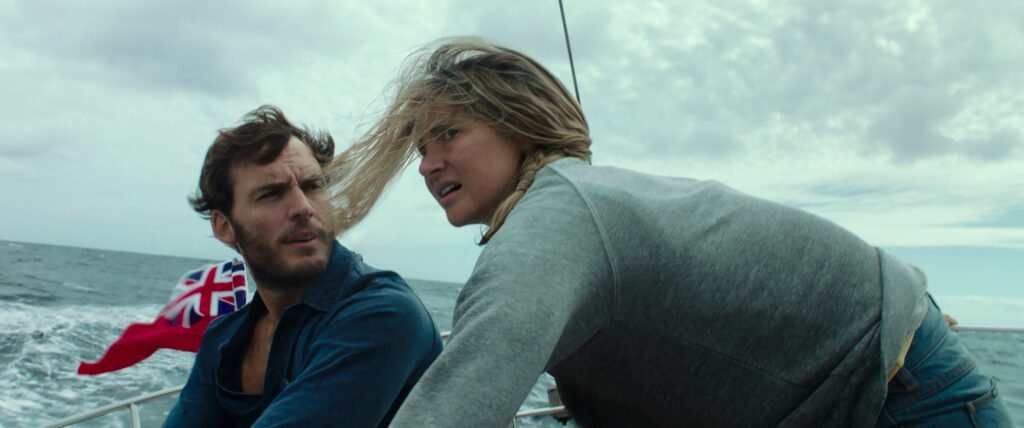
Adrift
Tami Oldham Ashcraft and Richard Sharp, her boyfriend, were recruited to sail a 44-foot yacht from Tahiti to San Diego in September 1983. Halfway through their journey across the Pacific Ocean, they encountered Hurricane Raymond, a tropical cyclone that had been gaining strength for several weeks. The boat was difficult to control in winds of 145 knots as Sharp was thrown overboard by waves “the size of mountains.”
Ashcraft suffered a head injury and lost consciousness for some time; the vessel was severely damaged. After eventually regaining her strength enough to move about again, she rigged makeshift sails using what little material remained on board before steering manually using only an old-fashioned navigational instrument known as a sextant along with an ordinary wristwatch more than 1,500 miles toward Hawaii over the course of 41 days while surviving on peanut butter alone.
In 2002 Ashcraft penned Red Sky in Mourning: A True Story of Love, Loss and Survival at Sea about her ordeal which was later adapted into this film by director Baltasar Kormákur who doesn’t exactly play coy with its emotions. Even though it’s one helluva survival tale where every breath counts against all odds stacked high against them there are other things going on too beneath those choppy waters so turbulent you’d swear they were raging inside your own chest cavity (or perhaps even lower).
She looks at maps, through the sextant, does maths, all while dehydrated (and possibly still concussed from her head injury). “Adrift” has a lot in common with a 2013 film called “All Is Lost,” which stars Robert Redford, and also some very important differences. In “All Is Lost,” Redford is the only person. There’s no dialogue; he doesn’t talk to himself or let us know what he’s thinking.
There’s no Wilson like in “Cast Away,” a thing for the stranded character to speak his feelings at. In “All Is Lost,” it’s silent and huge. We don’t know who the character is, we don’t know why he’s there alone, we don’t know his life onshore. All we see him do is try every gritty step of the way to survive one more day.“Adrift” sidesteps many of the challenges that “All Is Lost” faces head-on.
Kormákur makes movies about survival (“Everest,” “The Deep”), and frequently sets those stories in Iceland, his home country and a land of sea and storms. This is familiar ground for him. Cinematographer Robert Richardson Quentin Tarantino’s usual cinematographer, also Oliver Stone’s and Martin Scorsese’s does amazing work here.
The wide overhead shots of the little yacht surrounded by vast ocean: The frame feels almost existentially empty. There’s one scene you’ll swear had to have been shot by someone perched out in mid-air beside a waterfall: first Tami jumps off a cliff into deep pool below; then Richard jumps off that same spot later on in the movie, camera following him down. Wallace Oates would be proud of these oozing fiery sunsets; yacht black-silhouetted against them.
This must have been an absolutely brutal shoot for everyone involved, and Kormákur maintains such control over the images. Shots match, even out in open ocean: weather, sky, height and dip of waves in any given sequence all hold steady.The storm itself when it finally comes is a piece of extraordinary filmmaking and effects. In an interview when her book came out, Tami Ashcraft was asked about whether or not the storm depicted in the film adaptation of “The Perfect Storm” was an accurate depiction of what such a storm is like.
She replied, “There wasn’t enough spray and the wall of water was a little hokey.” There’s nothing hokey about this one (Dadi Einarsson supervised the visual effects).As the yacht surfs up the side of a mountain of water, the entire background of the screen fills with heaving ocean. There’s no sky here; just flailing waves that are three stories tall. And they heard Ashcraft loud and clear: Spray fills the air, splashes against camera. It’s chaos. The whole scene is a screaming nightmare come to life.
There’s minimal chemistry between these two actors; they’re not given much to work with by way of who these characters are. It’s hard to buy into the Great Love they’re selling here. But there’s always something fascinating about stories like this one, or like “Touching the Void,” or “And I Alone Survived.” What human beings will do to survive when faced with Mother Nature who seems hellbent on killing them is nothing short of awe-inspiring.
It makes you ponder, “How will I confront such difficulties? Could I improvise like Tami or will my response be to quit?”
Watch Adrift For Free On Gomovies.
.jpg?w=1024&resize=1024,1024&ssl=1)
.jpg?w=1024&resize=1024,1024&ssl=1)
.jpg?w=1024&resize=1024,1024&ssl=1)
.jpg?w=1024&resize=1024,1024&ssl=1)
.webp?w=1024&resize=1024,1024&ssl=1)
.jpg?w=1024&resize=1024,1024&ssl=1)
.jpg?w=1024&resize=1024,1024&ssl=1)
.jpg?w=1024&resize=1024,1024&ssl=1)